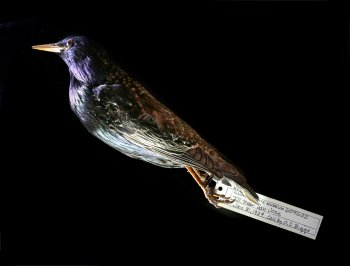European Starling
European Starlings (Sturnus vulgaris) are ubiquitous across North America, where they compete with native cavity-nesting birds for space. They are typically around 8-1/2 inches long and have a wingspan of 15 inches. They reportedly were brought to the Americas by a fan of William Shakespeare who set out to introduce every bird mentioned in the Bard’s work to the New World. In 1890, Eugene Schieffelin released 60 starlings in Central Park in New York City, and the rest was “to be.” Immigrants brought many plants and animals from home when they resettled in the New World, and most of them behaved well enough. However, a few became invasive, meaning they caused ecological or economic harm. (Consider garlic mustard, an herb brought by settlers to use as a substitute for garlic. It escaped cultivation and is now a serious forest invader.)
Starlings do well in the wake of civilization, but they didn’t spread over the entire continent all at once. The European Starling pictured here was the first collected in central Illinois near San Jose on the last day of 1929, about 40 years after that documented release. By comparing when they are collected, specimens in museums can help us track changes in distribution over time. This specimen was collected and prepared by Oliver S. Biggs (1861-1947). Biggs was an amateur taxidermist who was taught by his mother, and then he passed his knowledge down to his daughters. The Biggs family had a small natural history museum in the attic of their San Jose home. School groups from the area would even make trips to see the displays.
This specimen is not a taxidermy mount. It is called a “study skin.” Study skins are specimens that are preserved and stuffed with cotton material and arranged in a simple, uniform position so they can be stored in drawers. These specimens are not intended for display but rather for research. By maintaining specimens in museum collections, much information can be gleaned from them.





